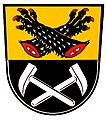Hertenberg (Vogtland noble family)
The von Hertenberg family was a widespread Vogtland noble family.
history
The eponymous headquarters Hertenberg (or Hartenberg) ( Hřebeny ) is located in the Czech Republic and is part of the Josefov municipality , today the Hartenberg castle ruins .
The Hertenbergers were first mentioned in a document on the occasion of the transfer of the Mitterteich estate to the Waldsassen monastery in 1230, when a "dominus vero de Hartenberch" was named, a nobleman who once owned the Tirschenreuth estate and the 1230 lord of Hertenberg was.
When the Lords of Liebenstein near Eger died out in 1298, Ulrich von Hertenberg laid claim to rule from the dowry of his wife Katharina. The Liebenstein lordship then came into the possession of the Waldsassen monastery in return for cash benefits until the final settlement in 1308.
At the beginning of the 14th century, the Hertenbergers expanded their property into the Vogtland, the area around Eger and the northern Upper Palatinate: from 1300 onwards, Tuto were and Heinrich von Hertenberg as heir to the Hohenberger ( Hohenberg an d. Eger ) lords on Schönbrunn (city of Wunsiedel ) and Redwitz ( Marktredwitz ) in the Vogtland. In 1317 Taut von Hertenberg, known as von Schönbrunn, transferred the Veste Schönbrunn with all affiliations and fiefs to the Waldsassen monastery, namely the villages of Watzkenreuth (near Nebanitz), Rossmeisl (near Heinrichsgrün), Seussen (between Arzberg and Redwitz), Tiefenbach (near Wunsiedel) , Hauenreut (near Redwitz) and Drosmansperch (?), Furthermore half the village Altengrün (near Heinrichsgrün), his possessions in Tröstau (near Wunsiedel) and his rights to mines and forests in the vicinity of Hertenberg.
In 1303, Tuto von Hertenberg and Schönbrunn was also named as the lord of Burg und Herrschaft Königswart (near Marienbad in Bohemia), and in the following year he was also proven to be the owner of Mühlessen und Grün (northeast of Eger). During this time, Tuto also took on the role of judge in the Egerland (iudex provincialis). In 1318 Tuto (Taut von Schönbrunn) had to give up his property in Upper Franconia (the city of Hof and the Regnitzer Land) at the instigation of Burgrave Friedrich von Nürnberg and "sin diener daz land rvmen vnd kain wonunge mer in it". How he came into possession of this territory is not clear from the documents.
In 1320 Albrecht, Konrad and Haward von Hertenberg sold all the goods in the villages of Albenreuth and Alt-Albenreuth to the abbot of Waldsassen for repurchase. In the Hartenberg feudal lapel of January 2, 1350, the sons of Albert I von Hertenberg had to accept the Hertenberg possessions that had previously been owned by Emperor Charles IV as a fief and vassal of the crown of Bohemia. This document explicitly lists the villages of the <Herrschaft Hartenberg: Gossengrün (Krajkova), Loch ( Dolina ), Blumberg ( Květná ), Adelsberg ( Leuchtadt - Olovi ), Bürgleins (Pürgles, Hrádek ), Lupardsgrün, Prünles ( Studenec ), Leopoldshammer ( Leopoldovy Hamry), Radwandsgrün (Robesgrün), Werth ( Josefov ), Oberschossenreuth ( Horni Castkov ), Lauterbach, Markwartsgrün (Marklesgrün) and half the village of Horn with the lead mines.
In the 16th century the family also owned Miltigau in the Egerland , Tröstau and Vordorf . Relatives also played a role in the Tirschenreuth area at an early stage and in Thuringia as late as 1760. The Hohenberg , Schirnding and Kotzau families are also related .
coat of arms
The coat of arms in Scheibler's book of arms shows two diagonally crossed black bear paws with extended claws on a golden background. The helmet covers are black and gold. The crowned crest repeats the animal's paws, this time erect and with the claws turned outwards. In the various representations, the bear paws differ, some of which are very vividly raised in threatening gestures , so that the strength of bears that lived in the regional forests is more emphasized, and some are depicted as cut stumps.
While Scheibler's book of arms and one of the sequels by Johann Siebmacher classifies the family as a Bavarian noble family , it appears in the Ingeram Codex as a member of the unicorn society .
Hertenberger bear paws in later municipal coats of arms:
literature
- Bernau Friedrich: Album of the castles and palaces in the Kingdom of Bohemia. 1st volume. Saaz 1881. With a history of the Hertenberg rule
- Brenner Johann B .: History of the Waldsassen Monastery and Abbey, Nuremberg 1837.
- Rudolf Johann von Meraviglia-Crivelli : Siebmacher's Wappenbuch, Nuremberg IV. Volume, 9th Division (1886) The Bohemian Nobility; reprographic reprint: 1979 The arms of the Bohemian nobility. J. Siebmachers´s big coat of arms, volume 30, Bauer and Raspe, Neustadt an der Aisch, ISBN 3 87947 030 8 , Hartenberg von Hartenberg p. 226, coat of arms 98
- Johann Siebmacher : Volume: BayA1 Page: 43 Plate: 43
- Kubu František: The Staufer Ministry in Egerland, Bamberg 1995
Web links
History of the Hartenberg rule http://gpecher.de.tl/Herrschaft-Hartenberg.htm
Individual evidence
- ↑ Gradl Heinrich: Monumenta Egrana. Monuments of the Egerland as a source for its history, vol. I: 805 to 1322, serial no. 179
- ^ Gradl: Monumenta I, serial nos. 535 and 536 p. 197, serial no. 579 p. 213.
- ↑ Gradl: Monumenta I, serial numbers 536 and 540, p. 197 f.
- ↑ Amberg State Archives, Waldsassen Monastery, signature StAAM documents 199.
- ↑ Gradl: Monumenta I, serial no. 552, p. 203.
- ↑ Gradl: Monumenta I, serial no. 665, p. 246.
- ^ Gradl: Monumenta I, p. 258.
- ↑ Archivum coronae regni Bohemiae II p. 155.





